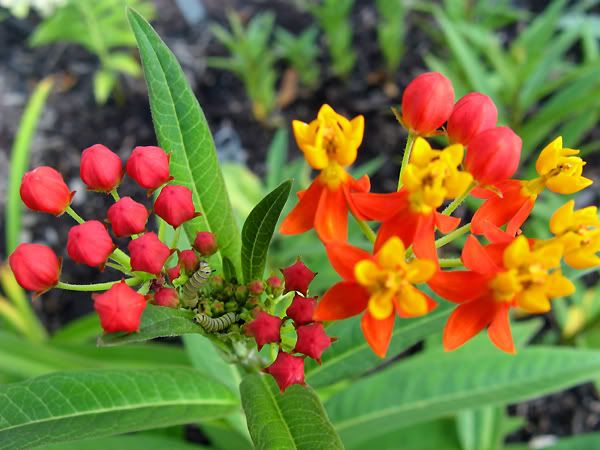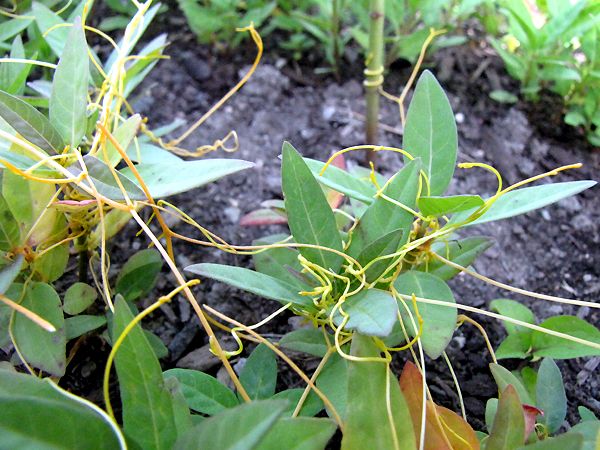Yesterday, when I blogged about the wicked and disgusting Iris borers, Romie made the comment, "It's always something." So true. And today's something is dodder. Never heard of it? Neither had I. I'd never seen it prior to this summer either. I'd noticed orangey threadlike tendrils had been winding themselves around some of the Asclepias curassavica (Scarlet Milkweed) seedlings for a couple of weeks now. I tried pulling them off, but it wasn't as easy as it looked. Just when I thought I had it all, there was some more. And it was so tiny and so tenacious!This morning, I posted a description of what we had on Twitter and asked if anyone knew what it could be. I hadn't yet taken a photo of it, so I thought it might take awhile before someone recognized what I was talking about. But Annie in Austin knew right away: "Hope it's not dodder: http://bit.ly/3rmbZd."
I'd noticed orangey threadlike tendrils had been winding themselves around some of the Asclepias curassavica (Scarlet Milkweed) seedlings for a couple of weeks now. I tried pulling them off, but it wasn't as easy as it looked. Just when I thought I had it all, there was some more. And it was so tiny and so tenacious!This morning, I posted a description of what we had on Twitter and asked if anyone knew what it could be. I hadn't yet taken a photo of it, so I thought it might take awhile before someone recognized what I was talking about. But Annie in Austin knew right away: "Hope it's not dodder: http://bit.ly/3rmbZd."
Her link took me to the Missouri Botanical Gardens website, which I've used before in a number of ways, including their Kemper Center for Home Gardening. The information there confirmed that we did indeed have dodder (Cuscuta spp.).
Romie and I pulled the tendrils off and in the end, only had to pull a few seedlings before we got it all (as far as we know). This year hasn't been the best for growing annuals at Our Little Acre. Most of them should be way taller and blooming their heads off by now. Many of them aren't and this Asclepias is one of them. We just need some good hot weather and some rain!
The dodder wasn't having any problems growing though. We'll monitor that area, because I fully expect it to return. I'm checking out the possibility of using Preen® pre-emergent herbicide in the soil there to prevent its return, because that's something we have on hand. Glyphosate (Round-Up®) will kill the plant itself, but I'd rather prevent it from growing in the first place and don't really like using Round-Up® if we don't have to.
UPDATE: I received a response from the makers of Preen® today-
Dear Kylee,
Currently we do not have a garden product that will prevent Dodder weed seeds from germinating, nor do we have a product that will kill existing Dodder. We recommend you contact your local cooperative extension agency for their advice/recommendations on controlling this weed as eradication is almost impossible.
Thank-you & Have a good day!
Warmest Regards,
Terese Clay
Customer Service
Lebanon Seaboard Corporation
___________________
Photo of Asclepias curassavica in bloom was taken 8-23-08. If you click on the photo, you'll see a larger version and you might also see something besides flowers!

















 "Bejeweled"
"Bejeweled"



13 comments:
Thanks for the mention Kylee - saw dodder years ago along wire fencelines and once you see that creepy stuff you don't forget it, lol! At least it's in a bed where you can get at it.
The Asclepias curassavica that is an annual in the north is one of my favorites here. Sometimes it's an annual here but last winter two of my plants lived over and are blooming now, even in the heat. Hope we can both enjoy the orange flowers and the little striped ones.
Annie at the Transplantable Rose
Annie ~ Thank you SO much for identifying this for me! And so quickly, too! I'd googled different things and just couldn't come up with it. It's always helpful to know the enemy and to know it early. I think because of this, we'll be able to keep this one under control.
Now those Iris borers... >-(
Kylee,
I've seen huge masses of this dodder along the edges of woods before, never knew what it was. Glad it is not in our garden.
Lucky that Annie ID-ed it for you, I have never heard of it. What a pain!! Good thing you found out and took care of it and are on the lookout for more.
Thankfully I haven't seen it around here! Sorry it got onto your plants. If it reseeds like morning glories do then you may be seeing more of it.
Omigosh. How fortunate that you posted about dodder. I pass a place on a country road every couple of days and I've seen what looks like an orange mat growing near the side of the road. It must be dodder! And only a mile from my house! Thanks for alerting us. Glad it is an annual and I'll keep MY Preem handy too!
Great show of the baby cats on the milkweed. So cute, chewing away...
This is a new one for me Kylee. I hope to never encounter it. Right now the worst thing in my garden is the wild morning glories. They are so aggressive and kill all they decide to climb upon. UGH...
Butterfly weed, one of my favorite plants but I have yet to see a butterfly on the plant.
Kylee, I've never seen a Dodder and I hope I never see one! Thanks for the information, though. I've been warned! :-)
We dont have anything like that in the UK luckily only bindweed. As you say at least its your annuals thats are affected not your perennials
I hope I never see this as I had hoped to never see a Lyme disease rash. some times you say oh well and fight off the "something"
Hi Kylee, Don't stress on not knowing the dodder. I didn't either until I had it last spring-summer. I even had a garden tour during the time it was rapidly growing on my coreopsis. Boy do I ever feel stupid, even to this day. I finally figured it out. Can't remember how. I not only pulled the dodder but the coreopsis and sedum; which both had dodder went to the dump. Huge clumps of it. That must have been the ticket because it did not rear its ugly head this year. And believe me, I've been diligently looking for it.
On the borers. I was dividing mine this year and could tell some of the older clumps had been affected. Like you said it doesn't seem to overly affect the irises. I didn't investigate further to find the borers so your picture is awesome. Pink indeed! I think dividing should help and I seriously downsized my clumps. A neverending task. Thanks for two most informative posts. Love your irises!
Oh, that dodder looks like nasty stuff. I hope you are successful at removing it.
Post a Comment